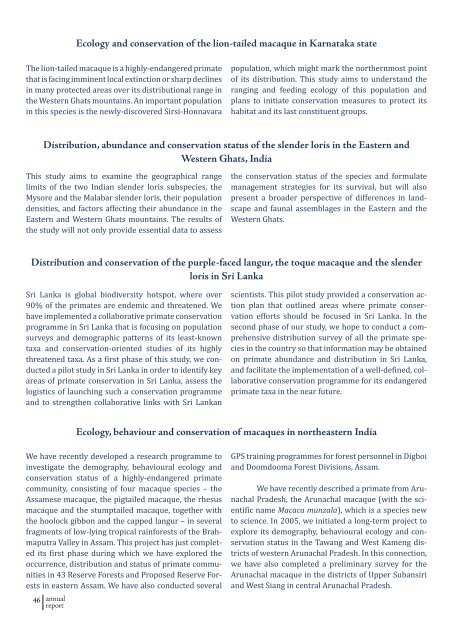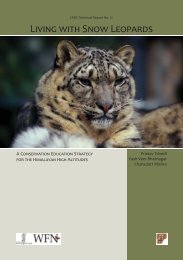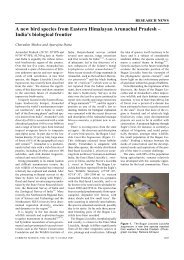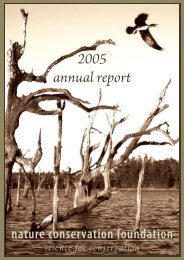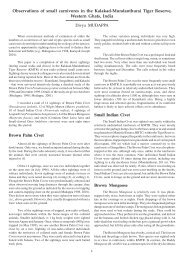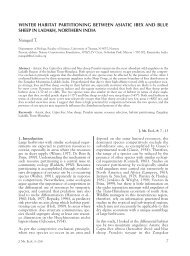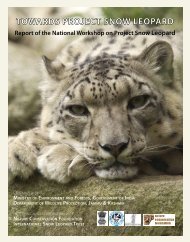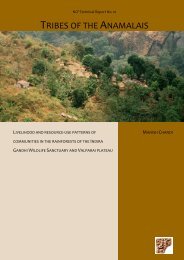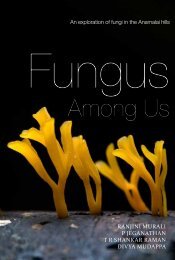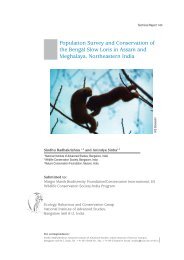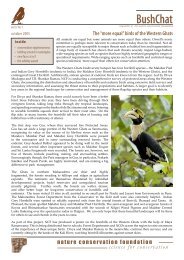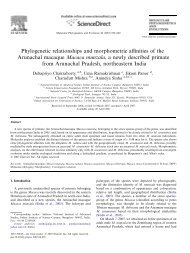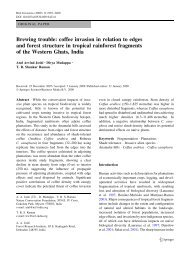2006-7 annual report - Nature Conservation Foundation
2006-7 annual report - Nature Conservation Foundation
2006-7 annual report - Nature Conservation Foundation
You also want an ePaper? Increase the reach of your titles
YUMPU automatically turns print PDFs into web optimized ePapers that Google loves.
Ecology and conservation of the lion-tailed macaque in Karnataka state<br />
The lion-tailed macaque is a highly-endangered primate<br />
that is facing imminent local extinction or sharp declines<br />
in many protected areas over its distributional range in<br />
the Western Ghats mountains. An important population<br />
in this species is the newly-discovered Sirsi-Honnavara<br />
population, which might mark the northernmost point<br />
of its distribution. This study aims to understand the<br />
ranging and feeding ecology of this population and<br />
plans to initiate conservation measures to protect its<br />
habitat and its last constituent groups.<br />
Distribution, abundance and conservation status of the slender loris in the Eastern and<br />
Western Ghats, India<br />
This study aims to examine the geographical range<br />
limits of the two Indian slender loris subspecies, the<br />
Mysore and the Malabar slender loris, their population<br />
densities, and factors affecting their abundance in the<br />
Eastern and Western Ghats mountains. The results of<br />
the study will not only provide essential data to assess<br />
the conservation status of the species and formulate<br />
management strategies for its survival, but will also<br />
present a broader perspective of differences in landscape<br />
and faunal assemblages in the Eastern and the<br />
Western Ghats.<br />
Distribution and conservation of the purple-faced langur, the toque macaque and the slender<br />
loris in Sri Lanka<br />
Sri Lanka is global biodiversity hotspot, where over<br />
90% of the primates are endemic and threatened. We<br />
have implemented a collaborative primate conservation<br />
programme in Sri Lanka that is focusing on population<br />
surveys and demographic patterns of its least-known<br />
taxa and conservation-oriented studies of its highly<br />
threatened taxa. As a first phase of this study, we conducted<br />
a pilot study in Sri Lanka in order to identify key<br />
areas of primate conservation in Sri Lanka, assess the<br />
logistics of launching such a conservation programme<br />
and to strengthen collaborative links with Sri Lankan<br />
scientists. This pilot study provided a conservation action<br />
plan that outlined areas where primate conservation<br />
efforts should be focused in Sri Lanka. In the<br />
second phase of our study, we hope to conduct a comprehensive<br />
distribution survey of all the primate species<br />
in the country so that information may be obtained<br />
on primate abundance and distribution in Sri Lanka,<br />
and facilitate the implementation of a well-defined, collaborative<br />
conservation programme for its endangered<br />
primate taxa in the near future.<br />
Ecology, behaviour and conservation of macaques in northeastern India<br />
We have recently developed a research programme to<br />
investigate the demography, behavioural ecology and<br />
conservation status of a highly-endangered primate<br />
community, consisting of four macaque species – the<br />
Assamese macaque, the pigtailed macaque, the rhesus<br />
macaque and the stumptailed macaque, together with<br />
the hoolock gibbon and the capped langur – in several<br />
fragments of low-lying tropical rainforests of the Brahmaputra<br />
Valley in Assam. This project has just completed<br />
its first phase during which we have explored the<br />
occurrence, distribution and status of primate communities<br />
in 43 Reserve Forests and Proposed Reserve Forests<br />
in eastern Assam. We have also conducted several<br />
46<br />
<strong>annual</strong><br />
<strong>report</strong><br />
GPS training programmes for forest personnel in Digboi<br />
and Doomdooma Forest Divisions, Assam.<br />
We have recently described a primate from Arunachal<br />
Pradesh, the Arunachal macaque (with the scientific<br />
name Macaca munzala), which is a species new<br />
to science. In 2005, we initiated a long-term project to<br />
explore its demography, behavioural ecology and conservation<br />
status in the Tawang and West Kameng districts<br />
of western Arunachal Pradesh. In this connection,<br />
we have also completed a preliminary survey for the<br />
Arunachal macaque in the districts of Upper Subansiri<br />
and West Siang in central Arunachal Pradesh.


